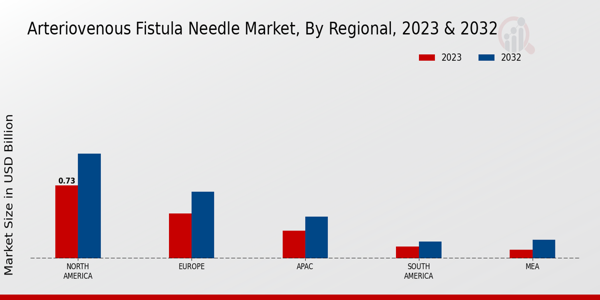Rising Prevalence of Kidney Diseases
The increasing incidence of chronic kidney diseases globally drives the demand for arteriovenous fistula needles. As the population ages and lifestyle-related health issues rise, the number of patients requiring dialysis is expected to grow. In 2024, the Global Arteriovenous Fistula Needle Market Industry is projected to reach 1.83 USD Billion, reflecting the urgent need for effective dialysis solutions. This trend indicates a sustained demand for specialized needles that facilitate efficient blood access during dialysis procedures, thereby enhancing patient outcomes and operational efficiency in healthcare settings.
Increasing Number of Dialysis Centers
The proliferation of dialysis centers globally is a critical driver for the arteriovenous fistula needle market. As healthcare systems expand their capabilities to accommodate the rising number of patients with kidney diseases, the demand for arteriovenous fistula needles is expected to surge. This trend is particularly evident in regions with high rates of kidney disease, where new centers are being established to meet patient needs. The Global Arteriovenous Fistula Needle Market Industry stands to benefit from this expansion, as it is projected to grow at a CAGR of 4.57% from 2025 to 2035, reflecting the increasing reliance on effective dialysis solutions.
Technological Advancements in Needle Design
Innovations in needle design and materials are enhancing the efficacy and safety of arteriovenous fistula needles. Manufacturers are increasingly focusing on developing needles that minimize patient discomfort and reduce complications associated with dialysis. These advancements not only improve the patient experience but also contribute to better clinical outcomes. The Global Arteriovenous Fistula Needle Market Industry benefits from these technological improvements, which are likely to attract more healthcare providers to adopt newer, more efficient needle systems. This shift is expected to support market growth as healthcare facilities seek to optimize their dialysis procedures.
Growing Awareness of Dialysis Treatment Options
There is a notable increase in awareness regarding dialysis treatment options among patients and healthcare providers. Educational initiatives and outreach programs are informing patients about the benefits of arteriovenous fistula needles, which are associated with lower complication rates compared to other access methods. This heightened awareness is likely to drive demand within the Global Arteriovenous Fistula Needle Market Industry, as more patients opt for dialysis treatments that utilize these specialized needles. As a result, healthcare providers are expected to enhance their offerings, further propelling market growth.
Government Initiatives and Funding for Kidney Health
Governments worldwide are recognizing the importance of kidney health and are implementing initiatives to improve access to dialysis treatments. Funding programs aimed at enhancing healthcare infrastructure and providing resources for kidney disease management are becoming more prevalent. Such initiatives positively impact the Global Arteriovenous Fistula Needle Market Industry by facilitating the availability of advanced medical technologies and treatments. As these programs expand, they are likely to increase the adoption of arteriovenous fistula needles, contributing to the market's projected growth to 2.99 USD Billion by 2035.

























Leave a Comment